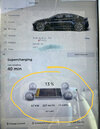UPDATE: May 3, 2021 - I got a call from one of the Service Technicians at the Superior Tesla Service Center. Aside from an apology for the prior miscommunications, he explained much, and per my request followed up with an email so I would have a record of our discussion. Here are excerpts from the email I received, which accurately reflects what we discussed as it pertains to the HV battery:
"Just wanted to follow up and try and provide a summary of what we discussed over the phone regarding the new HV battery we recently installed in your vehicle. I do apologize again for the miscommunication about the charging rates. Unfortunately, even though the battery itself is capable of charging at a higher rate, the other charging components installed in the vehicle are not capable of charging higher than what you are currently seeing under ideal conditions. This is something we definitely should have communicated better with you and I am sorry for that.
I asked one of the high voltage battery engineers about the change in voltage from 400 to 350 and found out the internal architecture of this battery is different than what your vehicle originally had installed. This new architecture actually allows for improved performance than your original battery was capable of at a slightly reduced voltage. This is due to some different battery cell chemistry as well as improvements to other hardware within the battery. These changes create a more consistent voltage during acceleration (less voltage drop) and improved and more consistent current flow to the drive unit increasing the performance of the vehicle.
The last thing I would like to mention is that the battery you have is completely brand new, no remanufactured or used parts are present, even the housing is a completely new piece. I hope this helps explain a little more about your battery. If you do have any further questions I can answer, please feel free to reach out."
I appreciate the communication and clarifications. We would have done the same repair with this information, but our expectations would have been different. I am satisfied with this response from Tesla.



